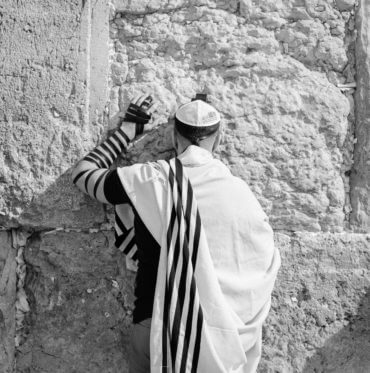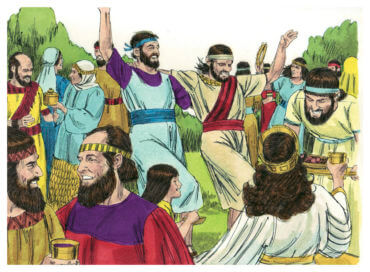What The Broken Tablets Can Teach Us About Coping With Loss
One of the most dramatic scenes in the Torah is when Moses descends Mount Sinai and sees the Jewish people dancing around the golden calf. Moses takes the two divinely-inscribed tablets he is holding in his hands and thrusts them to ground, shattering them. Whatever became of the tablets smashed by Moses?
The Talmud in Bava Basra answers that they were not buried, but were placed in the most sacred place: the Aron Hakodesh, the holy Ark. They sat next to the second, intact tablets. Together they remained securely protected as the nation journeyed through the wilderness. Why do the broken pieces remain precious? If they represent the Jewish people disregarding the covenant with God, would we not wish to simply forget about them?
The idea of brokenness appears in a number of significant places in Judaism: We sound the shofar with the broken notes of the shevarim; the Hebrew root word ‘shever’ means ‘broken’. We begin the Seder breaking a whole piece of matzah. When the bride and groom stand under the wedding canopy, a glass is shattered into pieces. These important symbolic rituals represent shattered and broken events in both our personal and communal lives. Brokenness and wholeness coexist side by side, even – and perhaps especially, in Judaism’s holiest spot – in the heart of the holy Ark.
The 16th century Kabbalistic work, Reshit Chochmah, teaches that the Ark is a symbol of the human heart.
People experience brokenness in many ways. One way that many of us experience despair and crushing pain is through the death of a loved one, especially when life is cut short. Those of us who have passed through the ‘valley of death’, those of us who have lost loved ones, know that we forever carry ‘broken tablets’. We carry the aching loss in our hearts and minds forever. The image of the broken tablets, unfortunately, offers an accurate representation of our lives and the life of the world around us. Loss forever remains a part of us.
We move through life now with two sets of tablets. There are times of joy; there are very happy times. They are encased in the same box; in the same heart. The commentator Rashi says that the two sets of tablets, the broken and the whole sets, sit touching one another. The seat of the emotions is found in the heart. Here, in this one enclosed space, emotions freely move from one place to the next.
The bereaved, and especially those that have suffered painful loss, often live their life with two compartments within one heart – the whole and the broken, side by side. To be a good friend is to know this and to be respectful of the brokenness that always remains. A friend never asks, “Are you over things yet?” or, “It would be best for you to move on.” Instead, a sensitive friend says, “What do you need most today?” or, “I will always be with you.” The most important thing we can do as friends, family, and as a community is to surround the bereaved with warmth and love, not only in the weeks and months following the loss, but continuously, even years later.
We help mend fractured hearts when we stay sensitive to those that need our empathy and support. This is how we bring about ‘shleimut’, wholeness, to a broken world. The Chassidic Rebbe, Reb Menachem Mendel of Kotzk said. “There is nothing more whole than a broken heart.” What does this enigmatic statement mean?
The heart can be patched after one confronts his brokenness and acknowledges his vulnerability. With great resilience, those who are broken still find the strength to lead fulfilling and meaningful lives. Many people have admirably found the faith and willpower from within, with the support of those around them to accomplish great things. They have ennobled and rebuilt their lives, even after suffering the deep pain of loss. This is a testament to the valiant spirit endowed in the soul of man. The desire on the part of the bereaved to keep the memory of loved ones alive and to eternalize their spirit inspires the bereaved to live with heroic determination and courage.
God cradles the broken tablets side by side with the whole ones in the holiest place in our tradition. The symbol of the broken tablets serves as a poignant reminder of our sacred responsibility to be ever-sensitive to those who suffer, embracing those who live with ‘broken tablets’ in their hearts.
Moses picked up each precious piece of the tablets, he collects every shard, and he lovingly places every piece in the holy Ark, conveying a message that guides the Jewish heart for all time.
If you found this content meaningful and want to help further our mission through our Keter, Makom, and Tikun branches, please consider becoming a Change Maker today.







1 comment
Sort by
Moshe Rabbenu gave the Torah to 3 million people who were standing in front of the mountain on which he had gone up. Gd spoke to Moshe in front of the entire nation – this is what it says in the Torah 24 times. The people who were standing there receiving the Torah told their children about it, and they told their children about it, until our times. If the proof of what 3 million people said is not good enough for you, what proof do you accept for other facts of history? Imagine that Jews did not have Moshe Rabbenu – someone else gave them the Torah. That person’s name would have been passed down throughout the generations. Imagine that the Jews did not receive the Torah the way it says. Someone came to the Jews to tell them hundreds of years later? That doesn’t work. They had already been celebrating Pesach commemorating their leaving Egypt, and Shavous, to commemorate the giving of the Torah. Someone came to the Jews hundreds of years later and said, Do this mitzvah and that mitzvah, and the people would say why? And he would tell them, bc many years ago someone named Moshe came down from the mountain and gave us a Torah. And that’s why we also have to eat matzah, bc we left Egypt and Gd gave us the Torah. All the Jews would laugh at him, bc no one would have ever heard that history from their parents and grandparents. He would never be able to get away with that. The fact that Gd gave the Torah to Moshe in front of the entire nation means much more than when other people say Gd came to them when they were alone and no one else saw, and He told the person that they don’t have to do all the mitzvos, or they have to wear burkas, etc. In those situations, no one saw those supposed revelations. But it is the most verifiable history when 3 million people experience something and pass that down to their children.